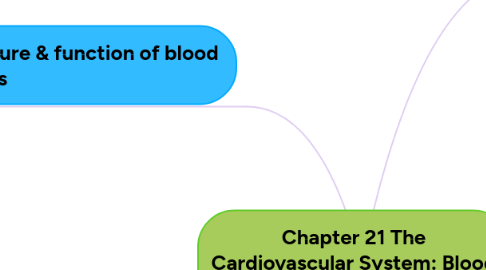Chapter 21 The Cardiovascular System: Blood Vessels & Hemodynamics
por Katie Wibking


1. Structure & function of blood vessels
1.1. Basic structure of a blood vessel
1.1.1. Tunica interna
1.1.2. Tunica media
1.1.3. Tunica externa
1.2. Arteries
1.3. Anastomoses
1.4. Arterioles
1.5. Capillaries
1.6. Venules
1.7. Veins
1.8. Blood Distribution
2. Checking circulation
2.1. Pulse
2.2. Measuring blood pressure
3. Shock & homeostasis
3.1. Types of shock
3.1.1. Hypovolemic
3.1.2. Cardiogenic
3.1.3. Vascular
3.1.4. Obstructive
3.2. Homeostatic responses to shock
3.2.1. RAAS
3.2.2. ADH
3.2.3. Sympathetic division of ANS
3.2.4. Vasodilators
3.3. Signs and symptoms of shock
4. Circulatory routes
4.1. Systemic circulation
4.2. Hepatic portal circulation
4.3. Pulmonary circulation
4.4. Fetal circulation
5. Capillary exchange
5.1. Diffusion
5.2. Transcytosis
5.3. Bulk Flow
5.3.1. Filtration
5.3.2. Reabsorption
5.3.3. Hydrostatic pressure
5.3.3.1. In blood
5.3.3.2. In interstitial fluid
5.3.4. Osmotic pressure
5.3.4.1. In blood (colloid)
5.3.4.2. In interstitial fluid
6. Hemodynamics: Factors affecting blood flow
6.1. Blood pressure
6.1.1. Systolic
6.1.2. Diastolic
6.1.3. Mean arterial pressure
6.2. Vascular resistance
6.2.1. Size of the lumen
6.2.2. Blood viscosity
6.2.3. Total blood vessel length
6.2.4. Systemic vascular resistance
6.3. Venous return
6.3.1. Skeletal muscle pump
6.3.2. Respiratory pump
6.4. Velocity of blood flow
7. Control of blood pressure and blood flow
7.1. Role of the cardiovascular center
7.2. Neural regulation of blood pressure
7.2.1. Baroreceptor reflexes
7.2.2. Chemoreceptor reflexes
7.3. Hormonal regulation of blood pressure
7.3.1. RAAS
7.3.2. Epinephrine and norephinephrine
7.3.3. ADH
7.3.4. ANP
